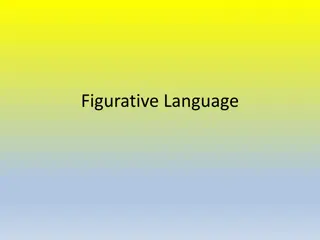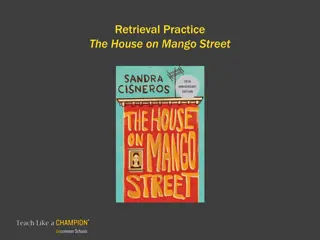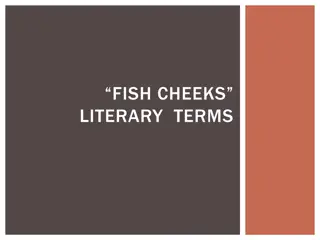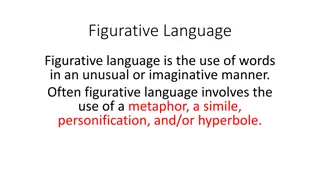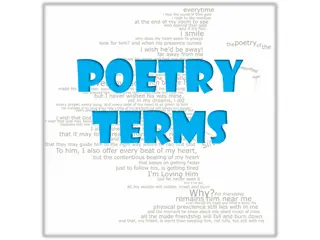Exploring Language in "The Dreadful Menace" Lessons
Delve into how authors use language in the poem "The Dreadful Menace" through activities such as producing initial responses, analyzing word choices, and discussing personification. Students engage with the text through discussions, definitions of key words, and examples of authorial intent, fosteri
0 views • 17 slides
Exploring Figurative Language: Hyperbole, Simile, Metaphor, Personification, Idiom, and Pun
Delve into the world of figurative language with examples of hyperbole, simile, metaphor, personification, idiom, and pun. Understand the art of exaggeration in hyperbole, the comparison of two objects in simile, the direct comparison in metaphor, giving human qualities to non-human entities in pers
1 views • 22 slides
Exploring Themes and Literary Devices in 'The House on Mango Street'
Delve into the world of Sandra Cisneros' novel, 'The House on Mango Street', through retrieval practice lessons. Learn about terms like ambiguity, personification, vignettes, and more. Understand the significance of motifs, slant rhyme, and alliteration as you uncover the layers of this captivating
1 views • 9 slides
Exploring Personification in "The Fog
The poem "The Fog" vividly portrays personification, attributing human qualities to the fog. Through descriptive imagery, the author showcases the fog as a character with hunched shoulders and wide arms, moving slowly and searching like a blind man. This personification enhances the reader's visual
0 views • 16 slides
Understanding Figurative Language Through Examples
Explore various examples of figurative language such as personification, idioms, similes, metaphors, hyperboles, onomatopoeia, and alliteration. Analyze each example and categorize them correctly in the provided grid to enhance your understanding of figurative language.
0 views • 7 slides
Figures of Speech
Explore the fascinating world of figures of speech with Dr. Somali Saha as we delve into the seven classes of figures. From simile to metonymy, antithesis to personification, you will discover the various ways language can be crafted to create engaging and impactful communication.
0 views • 10 slides
Crafting Suspenseful Narratives: Techniques and Examples
Experience the art of crafting suspenseful narratives through noun phrases, senses descriptions, personification, and more. Dive into examples like the eerie tale of Sarah facing the unknown in a mysterious hole. Unleash your creativity to engage readers and keep them on the edge of their seats. Enh
0 views • 10 slides
Exploring Literary Devices in 9th Grade English
Dive into the world of literary devices commonly studied in 9th-grade English classes. Discover the power of imagery in creating vivid sensory experiences, differentiate between metaphor and simile, explore extended metaphors that span beyond a single sentence, grasp the nuances of connotation and d
0 views • 7 slides
Understanding Personification, Simile, and Metaphor in Writing
Explore the concepts of personification, simile, and metaphor through examples and practice sentences. Understand how these literary devices enhance writing by giving non-human subjects human characteristics, comparing unlike things, and stating that one thing is another. Engage in exercises to iden
0 views • 6 slides
Stranded on a Desert Island: A Tale of Survival and Adventure
Embark on a thrilling journey as you follow a character who finds themselves shipwrecked on a deserted island. Through engaging storytelling and vivid imagery, explore the character's emotions, struggles, and triumphs as they navigate the challenges of the unknown. Dive into the depths of character
0 views • 15 slides
Exploring Figurative Language: Simile, Metaphor, Personification, Hyperbole
Figurative language enhances descriptions by comparing elements to create vivid imagery. This presentation explores simile, metaphor, personification, and hyperbole, providing examples and explanations for each. Similes use "like" or "as" to draw comparisons, while metaphors state facts metaphorical
0 views • 6 slides
Enhancing Writing Skills Through Varied Sentence Structures
Enhance your writing skills by incorporating diverse sentence structures like relative clauses, onomatopoeia, interesting openers, personification, similes, connectives, adverbs, and fronted adverbials. Practice through quick starts, onomatopoeia exploration, and slow writes to improve control and p
1 views • 6 slides
Literary Terms Exploration in "Fish Cheeks" Short Story
Explore essential literary terms such as point of view, imagery, simile, metaphor, and personification in the short story "Fish Cheeks." Understand each term's definition with examples from the text, enabling a deeper analysis of Amy Tan's storytelling techniques.
0 views • 7 slides
Exploring Figurative Language in Literature
Figurative language adds depth and imagery to writing by using words or expressions in a non-literal way. Common examples include simile, metaphor, personification, onomatopoeia, hyperbole, and symbolism. Similes compare two unlike things using "like" or "as," while metaphors directly equate them. P
0 views • 8 slides
Exploring Figurative Language: Metaphors, Similes, Hyperboles, and Personification
Figurative language enhances communication by using imaginative expressions like metaphors, similes, hyperboles, and personification. Metaphors compare two things directly, similes use "like" or "as," hyperboles exaggerate, and personification attributes human traits to non-human entities.
0 views • 5 slides
Reflections of an Indian Summer
The poem "Indian Summer" by Jayant Mahapatra vividly paints a picture of a hot and dreamy afternoon in India. Through personification of the wind and powerful imagery of funeral pyres, the poem captures the essence of the season. The poet reflects on life, death, and the unfolding of nature amidst t
0 views • 4 slides
Understanding Figurative Language: A Guide to Metaphors, Similes, and More
Figurative language is a powerful tool used by writers to evoke emotions and create vivid imagery in the minds of readers. It goes beyond literal meanings, allowing for deeper interpretations and connections with the subject matter. This guide explains the difference between figurative and literal l
0 views • 40 slides
Exploring Language Techniques in Poetry
Delve into the art of poetic expression through various language techniques such as simile, metaphor, personification, and more. Uncover how writers utilize these tools to create vivid imagery, evoke emotions, and enhance the overall impact of their work.
0 views • 7 slides
Exploring Figurative Language in Writing
Figurative language enhances writing by creating visual imagery and deeper meaning. Understanding its use improves reading comprehension, plot analysis, and character motivation recognition. Through examples like similes, metaphors, personification, and idioms, readers can grasp the nuances of figur
0 views • 9 slides
Mathematics and Language Homework Challenges
Navigate through a series of mathematical questions combining times tables and fractions, along with a poetic task using figurative language. Dive into solving equations, ordering fractions, and exploring literary devices like personification and metaphor. Additionally, discover the meanings of voca
0 views • 6 slides
Exploring Literary Devices and Techniques in Storytelling
Delve into the world of storytelling with an examination of key literary devices and techniques such as plot, exposition, rising action, climax, falling action, and denouement. Understand the significance of similes, metaphors, personification, and other tools that bring narratives to life.
0 views • 82 slides
Literary Devices Quiz: Can You Identify the Figures of Speech?
Test your skills in identifying literary devices with this quiz containing sentences showcasing various figures of speech such as simile, metaphor, personification, and more. Each sentence challenges you to determine the type of figure of speech used, providing an engaging way to enhance your unders
0 views • 22 slides
Exploring Social Class in "The Doll's House" by Katherine Mansfield
The short story "The Doll's House" by Katherine Mansfield delves into themes of social class, prejudice, connection, hope, appearance, and equality. Through vivid storytelling, Mansfield sheds light on the inhumanity of class discrimination and the longing for genuine equality. With rich metaphors,
0 views • 10 slides
Analyzing "The Next War" by Wilfred Owen: A Sonnet of Death and Hope
Wilfred Owen's poem "The Next War" explores shifting perspectives on death and war among soldiers in the trenches, using a unique sonnet structure blending Italian and English forms. Through inclusive language and personification of Death, Owen highlights themes of camaraderie, courage, and the acce
0 views • 9 slides
Examples of Figures of Speech in Poetry
This collection showcases various examples of figures of speech used in poetry by renowned poets such as Andrew Marvell, Coleridge, Wordsworth, R.S. Thomas, and John Donne. The excerpts include metaphors, similes, personification, and other literary devices, offering a diverse range of creative expr
1 views • 10 slides
Exploring Techniques in Jabberwocky Poetry Lesson
Dive into the world of poetry with an analysis of Lewis Carroll's "Jabberwocky". Students will learn to identify and understand various poetic techniques such as simile, alliteration, onomatopoeia, metaphor, and personification. Tasks include translating stanzas, finding examples of metaphors, onoma
0 views • 10 slides
Reflections on Death in John Donne's Poetry
John Donne's poem "Death, be not proud" challenges the conventional view of death as a fearsome force. The speaker addresses Death directly, asserting that it is not as mighty or dreadful as some believe. Instead, Death is portrayed as a servant to fate, chance, kings, and desperate men. The poem ex
0 views • 19 slides
Analysis of "The Love Song of J. Alfred Prufrock" in B.A. Hons Final Year at I.B. P.G. College, Panipat
The dramatic narrative poem by T.S. Eliot, "The Love Song of J. Alfred Prufrock," explores themes of unexpressed love, fear of rejection, and societal pressures. The middle-aged narrator struggles with courage to express his feelings, reflecting on aging, unfulfilled desires, and the impact of socie
0 views • 6 slides
Unseen Poetry Analysis: Winter Reflections in "Hard Frost" by Andrew Young
Explore the reflective nature of winter in Andrew Young's "Hard Frost" where the poet depicts the harshness and beauty of the season through vivid imagery and personification, highlighting the temporary nature of winter in the face of the impending arrival of summer. Analyze the portrayal of winter
0 views • 17 slides
Exploring Figurative Language in "The House on Mango Street
Dive into the world of figurative language in Sandra Cisneros' novel "The House on Mango Street" by exploring examples of imagery, metaphor, simile, personification, hyperbole, alliteration, assonance, and consonance. Discover how these literary devices enhance the storytelling by painting vivid pic
0 views • 11 slides
Intro to Poetic Devices in "The Raven
Explore the use of poetic devices in Edgar Allan Poe's "The Raven" with a focus on end rhyme, internal rhyme, rhyme scheme, personification, and more. Learn to identify and analyze these devices as they influence the understanding and impact of the poem's stanzas. Engage in a practical exercise to a
0 views • 43 slides
Understanding Figurative Language Through Quotations
Explore the concept of figurative language by analyzing quotations that demonstrate similes, metaphors, and personification. Discover how writers use comparisons to enhance meaning and develop a deeper understanding of literary texts.
0 views • 43 slides
Mastering Rhetorical Devices for Persuasive Speech - Tips & Examples
Unveil the power of rhetorical devices in persuasive speech through parallelism, rhetorical questions, analogies, personification, and allusions. Understand how to captivate your audience and convey your message effectively using these tools.
1 views • 11 slides
Analysis of Poetic Techniques in "Mrs. Midas" Verses for Mood Creation
Late September in "Mrs. Midas", the use of poetic techniques such as personification, contrast in consonant sounds, and building tension through language effectively conveys the relaxed atmosphere changing to chaos. The language choice in building up to the climax adds to the absurdity and horror of
1 views • 9 slides
Examining Literary Devices in Romeo and Juliet
This review explores key literary devices such as dramatic irony, situational irony, verbal irony, iambic pentameter, simile, metaphor, personification, imagery, and soliloquy in Shakespeare's Romeo and Juliet. Examples from the play illustrate how these devices enhance storytelling and character de
0 views • 17 slides
Poetry Terms and Examples of Sound Devices
Explore various poetry terms such as alliteration, assonance, consonance, onomatopoeia, end rhyme, internal rhyme, and personification with examples. Discover how these sound devices enhance poetry and create vivid imagery within verses. Dive into the world of poetic techniques through this comprehe
1 views • 9 slides
Narrative Writing Essentials
Explore the fundamentals of narrative writing, including definitions of key terms like melancholy, personification, and analepsis. Dive into vocabulary challenges and writing strategies for crafting effective narratives.
0 views • 15 slides
Understanding Figures of Speech in Writing
Learn about imagery and figures of speech in writing, including similes, metaphors, and personification. Immerse yourself in the use of words to create vivid images that appeal to the senses. Explore examples and gain insights into how these tools can enhance your writing.
0 views • 16 slides
Analysis of "There Will Come Soft Rains" by Ray Bradbury
In Ray Bradbury's "There Will Come Soft Rains," the story is set in a fully automated house after humanity has been wiped out. The absence of human characters is compensated by the depiction of the house as a character itself through personification. As the story unfolds, the house's attempt to main
0 views • 21 slides
Figurative Language Test Review and Practice
Review and practice identifying various types of figurative language such as simile, metaphor, hyperbole, personification, and more through matching exercises, multiple-choice questions, and sentence explanations. Enhance your understanding of figurative language with this interactive test review.
0 views • 4 slides

